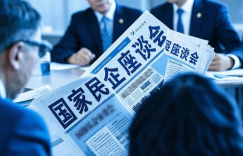
Today we continue to talk about the Trump storm. Before, Trump and his team had been trying to push for the termination of the “permanent normal trade relations” between China and the United States. This matter is very important, so let’s talk about it today. Because once it happens, it means that the economic trade between China and the United States will regress significantly, and it will affect the livelihood and life of each of us for a long time in the future.
How likely is it that China and the United States will decouple from each other’s trade?
What specific impact will it have? To answer this question, we must first clarify: What is “termination of permanent normal trade relations”? In fact, the predecessor of “permanent normal trade relations” is probably familiar to you. It was once called “most-favored-nation treatment”.
“Most-favored-nation treatment” is a preferential system commonly used in international trade. The basic principle is that the preferential treatment given to each other by the contracting parties in bilateral trade shall not be lower than the preferential treatment given to any third country now or in the future. Simply put, you can understand that I will always give you the lowest price.
After the establishment of diplomatic relations between China and the United States in 1979, the United States granted China “most-favored-nation treatment” for three years. Because the United States is in a strong position in Sino-US economic and trade relations, this “most-favored-nation treatment” is considered a “bonus” from the United States to China. However, every year, the United States needs to go through the review process again and the president approves the renewal. The uncertainty of annual renewal has brought fluctuations to Sino-US economic and trade relations. “Most-favored-nation treatment” has become a prominent contradiction in the development of Sino-US economic and trade throughout the 1980s and 1990s.
It was not until China joined the World Trade Organization, or WTO, in 2001 that the United States announced the following year based on the WTO cooperation framework that it would grant China “permanent normal trade relations treatment status” from 2002. This is essentially similar to “most-favored-nation treatment”, but it does not need to be renewed every year, symbolizing a more stable and continuous trade relationship.
Back to Trump’s statement, once he pushes for the termination of the “permanent normal trade relations” between China and the United States, it means that China can no longer enjoy the preferential tariff rates of the United States for most-favored-nation tariffs, and will be subject to non-most-favored-nation tariffs with an average tariff rate of up to 42%. Combined with the previous 20% tariff rate imposed under the 301 framework, the average tariff rate of the United States on China will exceed 60% – this is nearly 30 times higher than the average tariff rate of about 2.2% under the most-favored-nation policy of the United States.
Since this news is currently only in the “threat” stage, will it be thunder and rain? How likely is it that China-US trade will truly “decouple”? Although it is difficult for us to give a probability, from the current signs from all aspects, we can only say: there is a possibility.
On the one hand, Trump has basically achieved joint control over the Senate, the House and the Supreme Court. The act of canceling the most-favored-nation treatment is applicable to ordinary bills in domestic voting in the United States. It only requires more than half of the votes of the members of the Senate and the House to pass the vote. With Trump taking office and realizing the “three powers in one”, the possibility of obtaining more than half of the votes is very high. On the other hand, from the perspective of WTO rules, the United States is also allowed to cancel a country’s trade preferential policies based on national security considerations.
Impact on China and China’s response
Why is it said that once the “threat” becomes “reality”, it will have a relatively large impact on us in the future for a long time?
When it comes to this issue, we have to look back to the past few decades and see how China’s economy took off: You know, exports have made an indelible contribution to the rapid development of our country, and their contribution to GDP once accounted for more than 35%. Even under the influence of adverse factors such as the epidemic and the trade war in recent years, the contribution of exports to GDP has remained at around 18%, not counting the spillover effect of exports on other industries. Therefore, the leap-forward progress of China’s economy is largely due to the increase in exports. To some extent, I think that in the reform and opening up, the purpose of reform for a long time is to match further opening up.
The United States has long been China’s most important export destination, especially in terms of trade surplus. In addition, a surplus means that exports are greater than imports, that is, a country’s income from abroad is greater than its expenditure on foreign countries. The result of statistics by economist Dr. Gron is that in the past 25 years, the United States has been our largest source of trade surplus. Simply put, most of the money we earn from the surplus in international trade comes from the United States.
Therefore, once Sino-US trade is affected by the above, the pressure on us is self-evident.
According to the prediction of the world-renowned Bloomberg News, if the 60% tariff policy is really implemented, I am talking about the most determined and worst case scenario of the United States, then by 2030, the proportion of US imports from China may be very small, and the Sino-US economy will really be decoupled. Once this happens, China may face problems such as shrinking export markets, slowing foreign exchange reserves, slowing economic growth, and reduced employment opportunities, that is, it will face huge economic pressure.
Of course, there is no need to be too pessimistic about future expectations, because we will not impose unfair treatment on the United States without fighting back.
First of all, the country will continue to negotiate to avoid substantial “decoupling”, and China still has its own bargaining chips in this regard. I said in a previous lecture on the impact of Trump’s coming to power that in the modern economy, no one can do without each other among major countries. Trade wars, especially this kind of tragic trade war, are killing one thousand enemies and hurting eight hundred of oneself. This is a process of everyone’s tolerance.
On the US side, even if high tariffs were used before, except for cutting-edge technology fields such as semiconductors, other fields have not achieved decoupling and chain breaking with China, and the United States’ import dependence on Chinese products has increased from 14.8% in 2018 to 16.5% at the end of 2023, including many foreign companies that have moved out of China and then chose to withdraw.
All these illustrate a common trend: the United States cannot find other economies to replace “Made in China” for the time being. Moreover, imposing tariffs on Chinese products will also raise domestic commodity prices in the United States and cause substantial inflation. Trump also has to consider this point. These are China’s bargaining chips.
In fact, since the trade war 1.0, Chinese companies have been circumventing high tariffs in two ways: one is re-export trade, where Chinese companies export products to Vietnam, Laos, Malaysia and other countries, and then use these countries as a springboard to export to the United States and Europe; the other is going overseas, where Chinese companies go overseas in large numbers, set up factories in Southeast Asia, Mexico and other places, and sell to the United States, Europe or local markets nearby.
However, trade war 2.0 may be significantly different from 1.0. When the United States imposes tariffs, it begins to emphasize “origin traceability”, which means that re-export trade is likely to be unsustainable. Under such circumstances, going overseas will become more and more of a mainstream trend for companies, and now when companies go overseas to third countries, they find that the local market is also very open, especially some Southeast Asian countries, which are ushering in the two major periods of “younger” and “new industrialization”, and market demand is exploding, which is a good way for Chinese companies to choose market diversification.
The key is China’s own reform and development.
Secondly, pressure is also a driving force, which will prompt us to increase our efforts to “expand domestic demand” and further return to the root of “domestic demand”, that is, wealth creation and distribution. This is what I want to talk about more. In the face of pressure, the key lies in our own reform, because the outside is always uncontrollable and we can only rely on ourselves.
At present, the proportion of residents’ income in GDP in our country is still relatively low globally: according to the comparative statistics of Zhongtai Securities in 2020, China’s residents’ income accounted for 44.7% of GDP, while the United States was 83.4%, India was 76.9%, Germany was 60.7%, and the global average was about 60%. The low income directly affects the downstream consumer demand, making “expanding domestic demand” a difficult problem.
Therefore, in terms of wealth distribution, how to truly realize “raising the income of ordinary people” has become the key to the next step.
How critical is it? Just last December, at the Central Economic Work Conference, China’s most important economic conference of the year, the central government rarely took “promoting the synchronization of residents’ income growth and economic growth” as the core macroeconomic goal. This change is very big. You know, in the past 20 years, our macroeconomic goals have always been only four: economic growth, full employment, price stability and balance of international payments. This time, the Central Economic Work Conference listed “promoting residents’ income growth” as the fifth core macroeconomic goal, placing it on an equal footing with the first four. Simply put, the economy has grown, and the people must be able to make more money at the same time, which has become the core issue of economic development.
Moreover, the draft of the Central Economic Work Conference this time contains significantly more content about employment and income than in previous years. The central government realized that the previous growth of residents’ income did not keep up with economic growth, which caused everyone’s inconsistent perception: the macroeconomic situation looked good, but the micro-individual feeling was not good, and everyone was unable to generally enjoy the dividends of development, which not only affected stability, but also everyone’s consumer confidence. Now the central government said that “promoting residents’ income growth” should be achieved as a core goal. Therefore, the document mentions measures including increasing income and reducing burdens, increasing employment, and innovating service consumption to promote and stimulate domestic demand and consumption.
But the income growth we just mentioned must keep up with the speed of economic development, and expand consumption and domestic demand. The core behind it is to add money.
How to add money? The statement in the draft of the Central Economic Work Conference is “to implement a more active fiscal policy, increase the fiscal deficit rate, and ensure that the fiscal policy continues to work hard and is more powerful.” Simply put, the central government should borrow more and spend more. The direct use of the expression “increase the fiscal deficit rate” in the document has never happened in the past ten years. What does this mean? It means that the government is determined to spend more money than it collects next year, and it will spend a lot more than before. For us ordinary people, it means that the government will invest more funds in multiple fields, create jobs, and directly or indirectly increase everyone’s income. You see, the money is coming.
To sum up, in this lecture today, I analyzed for you the possibility and potential impact of the United States canceling China’s “most-favored-nation treatment”. But we don’t need to be overly pessimistic. Pressure is also motivation. The process of dealing with these challenges will also have a far-reaching impact and ultimately change our own development. Since the external environment is always difficult to control, only self-reliance is the best path to rely on in the long run.
Breaking from the outside is pressure, breaking from the inside is growth. This is true for both the country and the people.



